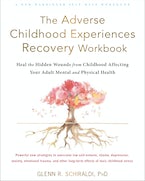By Glenn R. Schiraldi, author of The Adverse Childhood Experiences Recovery Workbook
Twenty-three years ago, medical doctors Vicent Felitti and Robert Anda demonstrated that adverse childhood experiences (ACEs) predicted in a graded fashion the occurrence in adulthood of a wide range of psychological, medical, and functional challenges. Analyzing the records of more than 17,000 middle-class, employed adults with health insurance at a large HMO in San Diego, CA, they found that about 2/3 of the adults had experienced at least one of the ten most commonly reported ACEs—emotional, physical, or sexual abuse; physical or emotional neglect; living in a home where there was an absent biological parent, domestic violence, someone who is mentally ill or suicidal, someone addicted to drugs or alcohol, or someone who was incarcerated. (Undoubtedly, many other ACEs could be added to the original ten.) The researchers have urged health practitioners to treat not only the smoke (depression, anxiety, drug abuse, heart disease, cancer, autoimmune disease, and many other stress-related conditions), but to also treat the flames (the hidden wounds from toxic stress experienced in the first eighteen years of life). Subsequent research has consistently linked ACEs to an ever-growing list of deleterious health outcomes. The prepared practitioner will be prepared to treat trauma—not just recent traumas but also the underlying wounds from childhood that, if unresolved, continue to cause so much suffering. This blog will explore principles for therapists who wish to help adult clients heal the wounds from toxic childhood stress.
The Healing Therapeutic Climate
The child’s developing brain requires a climate of safety, calm, and love in order to develop properly—wiring in ways that effectively regulate physical and emotional stress. In order to rewire distressing memories, the emotionally wounded adult needs a similar climate. Rather than being aloof or neutral, clinicians must be actively and consistently kind and warm. Think full presence, Carl Rogers’s unconditional positive regard, or Mother Teresa’s showing love by the way she spoke to, looked at, and listened to people who were suffering. In that safe therapeutic environment, the clinician can help the client overcome avoidance, guiding them to—at their own pace—accept their history and their pain as a first step to healing. They learn to bring their pain into the light of day where love and acceptance can heal that pain.
Messages the Client Needs to Know
- Healing can occur at any age.
- Healing requires an active stance—turning toward the pain and practicing healing skills.
- Trauma is a soul wound that typically results in a shattered sense of self and a felt sense of worthlessness. Although these perceptions run deep, they are just perceptions, not reality.
- It is quite normal to wish to erase our painful history, which is impossible to do. Instead, we can learn to acknowledge the pain, surround it with love and acceptance, and begin to pendulate to life’s loveliness. The pendulum swings back and forth between allowing the pain in (and soothing it with compassion) and enjoying life’s pleasant emotions. Over time, the unpleasant times become less troubling, while the ability to enjoy life increases.
Therapeutic Approaches that Work
Difficult childhood memories are managed by the visual, nonverbal right brain, with its deep connections to the emotional and survival regions of the brain. The left brain allows one to consciously recall and talk about memories, but in the earliest months and years the verbal, logical left brain is not fully developed, and thus is not yet “online.” In the later years of childhood, the left brain goes offline during times of overwhelming stress. During such times, the instinct to fight, flee, or freeze override the tendency to talk or reason (there’s no time for these). It is usually difficult for the adult to recall or put early disturbing memories into words. This is why traditional therapies that rely on talking and reason are usually not effective, at least initially, with trauma clients.
The right brain manages nonverbal aspects of memories that are typically below the level of conscious awareness. These aspects of ACE memories include images (such as facial expressions of the caregiver or perpetrator), visceral experiences (such as nausea or tightening of the gut or chest), survival tendencies (such as the impulse to run, hunch shoulders, or freeze), and a pervasive, wordless sense of danger or shame.
Implicit memories are situated in the right, emotional, and survival regions of the brain and might not be accessible to words and logic. Newer treatment approaches to rewire implicitly imprinted ACE memories start with strategies that target areas of the brain that regulate images, emotions, and bodily sensations. These strategies include:
- Nurturing imagery helps to strengthen and stabilize the nervous system prior to beginning memory work by creating new, positive neural circuits. Various imagery exercises simulate the attachment experiences that were needed, but lacking developmentally, while self-nurturing imagery creates additional positive neural circuits and patterns of coping.
- Regulating dysregulated stress arousal. Arousal dysregulation occurs when one is stuck on stress arousal that is too high (hyperarousal) or too low (hypoarousal—collapse, numbing, freezing). Most who are affected by trauma are stuck on hyperarousal, while a minority are stuck on hypoarousal. The latter results either from exhaustion or from encountering a particularly overwhelming acute stressor. The goal is to help clients return to the “window of tolerance,” where stress arousal is neither too high or too low. In this window, all regions of the brain are back online, including the left brain and regions that give the client a sense of connection to oneself and one’s emotions. In this window, memory work can proceed. The body-oriented strategies pioneered by master clinicians Pat Ogden, Bessel van der Kolk, and Peter Levine start with putting the trauma story aside and calming the body in order to, in a bottom-up fashion, calm the emotional and survival regions of the brain. Tracking, or paying close attention to what is happening in the body, promotes calming and synchronizing of the various regions of the brain.
- Regulating intense emotions. Chronically elevated emotions such as anxiety, grief, or anger can maintain dysregulated stress arousal. Therapists can equip clients with a variety of skills that the client can use both during treatment and in everyday situations.
- Floatback strategies enable clients to soothe and settle both recent emotional upheavals, and the childhood memories that fuel recent overreactions and distorted thinking.
- Rewiring shame, which can be imprinted beneath conscious awareness in the earliest months of life (e.g., the wordless image of a caregiver’s look of angry disgust can be imprinted in the infant’s developing brain, resulting in a persistent, felt sense of inadequacy).
- Transitioning to a satisfying life. While helping clients recover from old wounds is a critical aspect of therapy, the work is incomplete without equipping them with skills to create a fulfilling life. The client can be guided to cultivate self-respect and self-esteem, forgive, feed the soul, and weave joy into their lives.
In future blogs, we’ll explore some impressive new treatment modalities that skillfully apply these principles, as well as practical tips for applying these principles in your practice.
Glenn R. Schiraldi, PhD, Lt Col (USAR), has served on the stress management strategies at The Pentagon, the International Critical Incident Stress Foundation, and the University of Maryland School of Public Health—where he received the Outstanding Teaching Award and other teaching/service awards. His fourteen books on stress-related topics have been translated into fourteen languages, and include The Adverse Childhood Experiences Recovery Workbook, The Post-Traumatic Stress Disorder Sourcebook, The Resilience Workbook, and The Self-Esteem Workbook. He has trained laypersons and mental health professionals around the world on various aspects of stress, trauma, and resilience.



 2024 Peace Playbook: 3 Tactics to Avoid Clashes with Your Partner
2024 Peace Playbook: 3 Tactics to Avoid Clashes with Your Partner